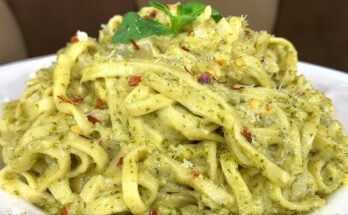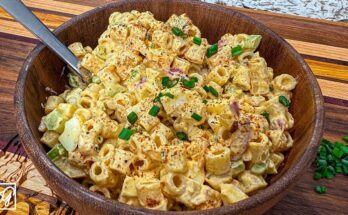Egg Flower Soup Recipe: There’s something incredibly comforting about a warm bowl of egg flower soup. It’s silky, savory, and so simple to make that once you try it, it might just become a staple in your kitchen.
Whether you’re craving something cozy or need a quick fix for a cold night, this egg drop-style Chinese soup is a go-to.
Let’s break it down step-by-step.
What is Egg Flower Soup?
Egg Flower Soup, also popularly known as Egg Drop Soup in Western regions, is a light, brothy Chinese soup enriched with wispy, delicate ribbons of egg. The “flowers” in the name refer to the beautiful petal-like shapes the eggs form when stirred into the hot soup. It’s often flavored with simple ingredients like ginger, scallions, white pepper, and a hint of sesame oil or soy sauce.
This soup is not only pleasing to the eye but also packs comfort and nutrition into a humble bowl. The eggs add a protein punch, while the broth delivers warmth and a burst of umami. It’s incredibly quick to make — we’re talking under 15 minutes — and needs only a handful of pantry staples.
You might see variations of this soup served in Chinese restaurants as an appetizer or a side. However, its ease and low cost make it just as popular as a homemade favorite. You can also modify it endlessly — think of adding tofu, mushrooms, corn, or even a splash of vinegar for a tangy twist.
Origins and Cultural Importance
Egg Flower Soup traces its roots back to traditional Chinese cuisine. The practice of whisking eggs into hot broth has been around for centuries, with variations across regions. While the classic Cantonese version is clean and simple, Northern Chinese versions might incorporate more spices, veggies, or even meats.
In Chinese culture, soups are not just meals but healing tonics. They’re often served to comfort the sick, nourish the body during winter, or balance the body’s “yin and yang” according to traditional Chinese medicine. Egg Flower Soup fits perfectly into that narrative — it’s light yet satisfying and believed to help balance the stomach and boost immunity.
Interestingly, while many in the West see it as a restaurant dish, in China it’s a common household meal. It reflects the elegance of Chinese cooking: turning humble ingredients into something both beautiful and delicious.
Ingredients You’ll Need
Core Ingredients
To make a traditional Egg Flower Soup, you only need a few basic ingredients. Most of them are likely already in your kitchen:
- Eggs (2-3 large): These are the stars of the show, providing those iconic ribbons.
- Chicken broth (4 cups): Use low-sodium broth for better control over saltiness. Vegetable broth works as a vegetarian option.
- Cornstarch (1 tablespoon): This thickens the soup slightly for a more velvety texture.
- Water (2 tablespoons): Mixed with cornstarch to create a slurry.
- Salt (to taste): Essential for seasoning.
- White pepper (a pinch): Adds gentle heat and aroma.
- Scallions (1-2, finely chopped): For freshness and crunch.
- Sesame oil (½ teaspoon): Optional, but adds rich nutty depth.
This combination creates a balanced, flavorful base that’s as comforting as it is nourishing.
Optional Add-ins and Variations
If you’re feeling adventurous or want to stretch the meal, here are some tasty additions:
- Sweet corn or cream-style corn – for a popular variation.
- Tofu cubes – extra protein and a creamy texture.
- Shiitake mushrooms – earthy flavor and umami boost.
- Soy sauce or light tamari – deeper saltiness and color.
- Chili oil or Sriracha – for a spicy kick.
- Spinach or bok choy – wilted greens make it even more wholesome.
Egg Flower Soup is like a blank canvas—you can customize it to your heart’s content based on your mood or what’s available in your fridge.
Tools and Equipment Required
Basic Kitchen Tools
The beauty of this dish lies in its simplicity — you don’t need fancy gadgets to whip it up. Here’s what you’ll need:
- Medium-sized saucepan or soup pot: Preferably one with a spout for easy pouring.
- Mixing bowl: For beating the eggs.
- Fork or whisk: To beat the eggs until fully combined.
- Ladle or large spoon: To stir the soup and drizzle the egg in controlled streams.
- Measuring spoons and cups: For accuracy in flavor and texture.
- Small bowl: For mixing the cornstarch slurry.
- Chopping board and knife: For prepping scallions or other optional ingredients.
Special Tips for Best Results
Here’s where a bit of kitchen wisdom comes in:
- Use a steady hand when pouring eggs. A slow, thin stream is key to getting that classic “flower” or “ribbon” effect.
- Keep the soup gently simmering—not boiling—when adding eggs. Too much agitation, and you’ll end up with scrambled egg soup.
- Whisk the broth in a circular motion as you pour. This creates the movement needed for the eggs to form delicate strands.
- Don’t skip the slurry. It’s tempting to go without it, but it transforms the soup from watery to silky smooth.
- Garnish just before serving. Scallions and sesame oil are best added at the last second for maximum flavor and freshness.
Step-by-Step Instructions to Make Egg Flower Soup
Step 1 – Preparing the Broth
Start by pouring your chicken or vegetable broth into a medium saucepan. Place the pot over medium heat and bring it to a gentle boil. If you’re using store-bought broth, go for low-sodium so you have better control over the seasoning. Homemade broth is even better, offering richer depth.
Once the broth starts to simmer, season it with salt and a pinch of white pepper. Add soy sauce at this stage if you’re using it, for a slightly deeper color and flavor. If you want a more traditional Chinese flavor profile, you can also throw in a few thin slices of fresh ginger to steep in the broth. Let everything simmer together for 5–7 minutes to blend those beautiful flavors.
While that’s cooking, mix your cornstarch slurry in a small bowl. Combine 1 tablespoon of cornstarch with 2 tablespoons of cold water. Stir until smooth—this slurry will help thicken your soup slightly, giving it that characteristic silkiness. Once your broth has simmered and you’re happy with the flavor, slowly stir in the slurry. Keep stirring while it simmers again for another minute or two, just until the soup gains that subtle thickness.
The broth is now your flavorful base, ready for the egg magic.
Step 2 – Beating and Seasoning the Eggs
While your soup base is simmering, take 2–3 large eggs and crack them into a small bowl. Use a fork or a whisk to beat them thoroughly. You want a smooth, even consistency without any egg white lumps. If you’re aiming for that iconic “feathered” look, ensure the eggs are beaten uniformly—no half-mixed yolks here.
Some people like to season the eggs lightly with a pinch of salt or white pepper. It’s totally optional but can give a subtle depth. If you’re going full creative mode, a dash of sesame oil or a small pinch of turmeric can add color and fragrance.
Don’t be tempted to pour the eggs in yet! Timing is crucial here. If the soup is too hot and boiling rapidly, you’ll end up with rubbery scrambled egg blobs instead of delicate ribbons. The soup should be gently simmering—like tiny bubbles, not a rolling boil.
Get your ladle or spoon ready, because now comes the most satisfying part.
Step 3 – Creating the “Egg Flowers”
This is where the magic happens.
Take your bowl of beaten eggs in one hand and a ladle or spoon in the other. Begin stirring the soup slowly in one direction—either clockwise or counter-clockwise. This swirling motion is what helps the eggs form those silky, petal-like ribbons.
Now, slowly pour the eggs into the gently swirling soup. You want to pour in a very thin stream—think of it like drawing a line with syrup. The slower and more even your pour, the better your “egg flowers” will turn out. Don’t dump the whole bowl in at once; it needs to drizzle in slowly while the liquid is moving.
As the eggs hit the hot broth, they’ll cook almost instantly, forming those beautiful strands. After you’ve added all the egg, let the soup simmer untouched for 30 seconds. This helps the egg set properly.
Once done, give the soup a gentle stir and admire those gorgeous ribbons.
Step 4 – Final Touches and Garnishing
Your Egg Flower Soup is nearly complete—now it’s time to garnish and elevate it.
Turn off the heat and stir in your chopped scallions. Their fresh crunch balances the soft texture of the eggs beautifully. If you’re a fan of sesame oil, drizzle a tiny amount (about ½ teaspoon) over the top. Its nutty aroma is the perfect finishing touch.
At this stage, you can also adjust the seasoning one last time. Need more salt? A touch of soy sauce will do. Want more heat? Add a sprinkle of white pepper or a few drops of chili oil.
Ladle your soup into bowls and serve immediately. Egg Flower Soup is best enjoyed fresh—those ribbons start to break down if it sits too long.
Pair it with steamed rice, dumplings, or a light stir-fry for a complete meal. Or just enjoy it as is—it’s soul food in the simplest form.
Tips for the Perfect Egg Flower Soup
Dos and Don’ts
Even though this is a beginner-friendly recipe, a few small missteps can impact the final texture and taste. Here are some do’s and don’ts to keep in mind:
Do:
- Beat the eggs thoroughly for smooth ribbons.
- Simmer the broth, don’t boil it, when adding the eggs.
- Stir the broth in one consistent direction while pouring.
- Add garnishes at the end for fresh flavor.
Don’t:
- Pour eggs in too quickly—this causes clumps instead of strands.
- Skip the cornstarch slurry if you want a rich, silky texture.
- Overcook the eggs; they only need seconds to set.
- Let the soup sit too long before serving—it’s best hot and fresh.
A little care makes a big difference. You’ll go from basic to restaurant-quality with just these tiny adjustments.
Flavor Enhancing Secrets
Want to take your Egg Flower Soup from good to unforgettable? Here are a few flavor-boosting secrets:
- Infuse with ginger: Add a slice or two to your broth early on and remove before serving.
- Use bone broth: Richer in nutrients and flavor than standard stock.
- Soy sauce variations: Try light soy for saltiness or dark soy for color and depth.
- Vinegar splash: A tiny bit of rice vinegar or black vinegar brightens the flavors.
- Spicy boost: Add white pepper generously or a few drops of chili oil.
You can make this dish as minimalist or as complex as you like, and it’ll still be comforting.
Common Mistakes and How to Avoid Them
Egg Clumping and How to Fix It
One of the most common frustrations when making egg flower soup is clumping eggs. Instead of those lovely thin ribbons, you get big chunks that resemble scrambled eggs. Why does this happen? It usually comes down to one thing—temperature.
When the broth is boiling too hard, the eggs cook instantly in large pieces before they have a chance to swirl into shape. To prevent this, always reduce the heat to a gentle simmer before adding the eggs. Stirring the broth in one direction helps keep it in motion, allowing the eggs to form threads as they cook.
Also, pouring too fast is a recipe for disaster. You want a thin stream—almost like you’re drizzling oil. The thinner the stream, the more delicate the final ribbons will be. Practice this technique, and it’ll become second nature.
If clumping still happens, don’t toss the batch! You can still enjoy it—just call it a rustic egg drop version. But next time, take it slow and keep that broth calm.
Over-seasoning or Under-seasoning the Broth
Because egg flower soup uses so few ingredients, the seasoning becomes ultra-important. If you under-season it, the soup can taste flat and bland. If you go too heavy on the soy sauce or salt, it can easily become overpowering.
Start with less and build your flavor gradually. Taste the broth before adding eggs and again just before serving. A pinch of white pepper or a couple of drops of sesame oil can completely change the flavor profile, so use them wisely.
Also, be careful if you’re using store-bought broth—it often already contains salt. Go for low-sodium versions so you can control the final flavor better. A light splash of rice vinegar or a sprinkle of sugar can even out excess saltiness if needed.
Health Benefits of Egg Flower Soup
Low-Calorie, High-Protein Meal
Egg flower soup is more than just tasty—it’s genuinely good for you. With only a few ingredients, it’s naturally low in calories and high in protein thanks to the eggs. One bowl typically contains fewer than 150 calories but gives you around 6–10 grams of protein. That’s a win if you’re watching your weight or looking for a nutritious, light meal.
The broth also hydrates you and helps with digestion, especially if you’re under the weather. That’s why this soup is often served to people who are recovering from illness—it’s easy on the stomach, comforting, and full of gentle nutrition.
You can make it even healthier by adding more vegetables like spinach, mushrooms, or corn. These additions provide fiber, vitamins, and minerals without adding many extra calories.
It’s also a great gluten-free option if you skip soy sauce or use a gluten-free tamari alternative. Perfect for almost any dietary plan.
Customizable for Dietary Needs
If you’re on a keto diet, this soup is ideal—just skip the cornstarch or use a keto-friendly thickener. Want it vegan? Swap out the eggs for soft tofu ribbons and use vegetable broth.
Egg Flower Soup is truly one of those recipes you can tweak endlessly to fit your dietary goals. It’s naturally dairy-free, and you can easily adjust the ingredients for low-sodium or low-carb needs.
Serving Suggestions
What to Serve with Egg Flower Soup
While Egg Flower Soup can definitely shine on its own, it pairs beautifully with other dishes. Here are a few delicious sides and mains to turn your soup into a complete meal:
- Steamed dumplings – Pork, shrimp, or veggie dumplings are classic pairings.
- Fried rice or plain jasmine rice – For a more filling combo.
- Spring rolls – Add a crispy contrast to the soft texture of the soup.
- Stir-fried vegetables – A healthy, colorful accompaniment.
- Lo mein or chow mein noodles – Hearty and satisfying.
You can also serve this soup as a starter for a full Chinese-inspired dinner or a light lunch with some crusty bread or a salad on the side.
Best Time to Serve
This soup is incredibly versatile. It works for lunch, dinner, or even a comforting breakfast (yes, seriously—it’s a thing in China!). It’s especially perfect:
- On a cold winter night.
- When someone in the family is sick.
- As a starter for a multi-course dinner.
- When you need a quick, no-fuss meal.
Whether you’re hosting guests or just need a quick bowl of comfort, Egg Flower Soup is the answer.
Storing and Reheating Tips
How to Store Leftover Egg Flower Soup
If you have leftovers, let the soup cool completely before transferring it to an airtight container. It will keep in the refrigerator for up to 3 days.
However, know that the texture of the egg strands may change a bit after sitting. They tend to break down and become less defined. The flavor will still be great, though!
Avoid freezing this soup. Eggs don’t hold up well in the freezer and can turn rubbery or grainy once thawed.
Reheating Without Losing Texture
To reheat, pour the soup into a saucepan and warm it slowly over medium heat. Don’t let it boil—just heat until it’s warm enough to eat. Stir occasionally to keep everything evenly heated.
If you find the texture too thin after refrigeration, you can add a touch more cornstarch slurry during reheating to restore that silkiness.
Top with fresh scallions or a drop of sesame oil to revive that just-cooked taste.
FAQs about Egg Flower Soup Recipe
1. Can I use vegetable broth instead of chicken broth?
Yes! Vegetable broth works beautifully and makes the dish vegetarian-friendly.
2. How do I make egg ribbons instead of clumps?
Pour eggs slowly into gently simmering broth while stirring in one direction for perfect ribbons.
3. Is Egg Flower Soup gluten-free?
Yes, especially if you use gluten-free soy sauce or tamari.
4. Can I add meat to this soup?
Absolutely! Shredded chicken or pork make great additions if you want to boost protein.
5. Can I meal-prep Egg Flower Soup?
It’s best served fresh, but you can refrigerate for up to 3 days and reheat gently.
Conclusion
Egg Flower Soup is a delicious, comforting dish that’s incredibly easy to prepare yet rich in flavor and tradition. Whether you’re craving something light, quick, or nostalgic, this soup hits the spot. With just a few ingredients and a few minutes, you can enjoy a dish that feels like a warm hug in a bowl. From beginner cooks to kitchen pros, everyone should have this timeless recipe in their back pocket.



